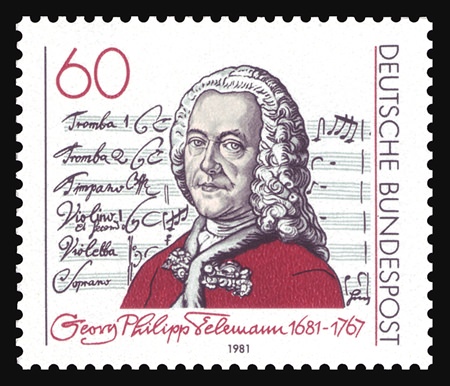
Think of three baroque composers and you’ll probably come up with Bach, Handel and Vivaldi. There were hundreds of others of course, most of which have fallen into oblivion and some of them rightly so. But in the early years of the eighteenth century, one of the most powerful voices was that of the German composer, Georg Philipp Telemann.
He was born on 14th March 1681 into a religious middle-class family in Magdeburg, a medieval town on the banks of the River Elbe. Telemann was virtually self-taught and today would be considered something of a child prodigy. He taught himself several instruments and began writing arias, motets and instrumental works, completing his first opera at the age of twelve. Despite this remarkable talent, his mother did everything possible to discourage him, having been influenced by the joyless Puritan Lutherans. At one point, this grossly misguided woman confiscated the boy’s musical instruments and commanded him to stop composing altogether. At about the age of twelve Georg was packed off to a school in Zellerfeld but the head teacher, to his eternal credit, recognised the boy’s extraordinary talents and provided much-needed encouragement.
In later years, Telemann started studying law at the University of Leipzig but the call of music proved irresistible. He began writing choral music for a church in Leipzig and quickly became a local celebrity. In 1702, at the early age of twenty-one, Telemann became director of the Leipzig Opera, and over the next few years he wrote several operas for the company. For a time, Telemann was the most famous musician in Germany. He held some of the most prestigious jobs available and evidently had a good sense of humour and a likable personality. Handel and Bach were among his personal friends, although interestingly, Telemann’s salary was about three times higher than that of Bach.
Telemann is one of the most prolific composers of all time. He wrote over a thousand church cantatas, a couple of dozen concertos, nearly fifty settings of the Passion and fifty operas. Just stop to think about that – fifty operas! It’s been estimated that he produced over three thousand musical works.
So what happened? Why is one of the baroque’s brightest stars so neglected today? Well, in the twilight years of the eighteenth century baroque music simply fell out of fashion to be replaced by the lighter musical styles of composers like Haydn, Mozart and the young Beethoven. The music of Bach was not rediscovered until the 1850s, a hundred years after his death. Bach was hailed as a master of the baroque at the expense of other composers of the period including Telemann, who remained in obscurity. It wasn’t until the middle of the twentieth century that a new interest in Telemann’s music brought him back into the limelight.
During the baroque period the concerto often featured two or more solo instruments, unlike the nineteenth century model which was usually for a single soloist. In case you’re wondering, the oboe d’amore is slightly larger than the standard oboe with a less assertive tone and the viola d’amore used in this recording has six or seven strings with an equal number of sympathetic strings below the fingerboard. These vibrate in sympathy with the played notes.
This exquisite work dates from around 1740 and has sensuous harmonies, elegant, tuneful melodies and beautifully transparent orchestration.
Just listen to the majestic choral opening of this work and you’ll hear a composer who really knew what he was doing. It’s one his finest works for choir and orchestra and dates from 1737 when Telemann was enjoying huge success in Paris. The work was written for the Concert Spirituel, one of the first-ever series of concerts intended for the general public. There’s some colourful orchestral writing and surprising harmonies which must have sounded very modern to the citizens of Paris.
In 1740, Telemann estimated that he’d already composed six hundred suites. Only about a quarter of them have survived and this is a splendid example of Telemann’s string writing, quite different in style from that of Bach and Vivaldi. The suite is typically composed of popular dances such as the bourrée, the gigue and the minuet and Telemann’s music is intensely rhythmic, enormously varied, with bubbling energy and a seemingly limitless display of musical ideas. There’s so much more of Telemann’s wonderful music waiting to be rediscovered. Let’s hope it doesn’t have to wait too long.
 |
 |
 |





